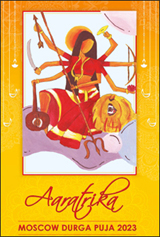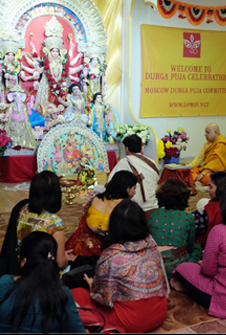Historty of Durga Puja

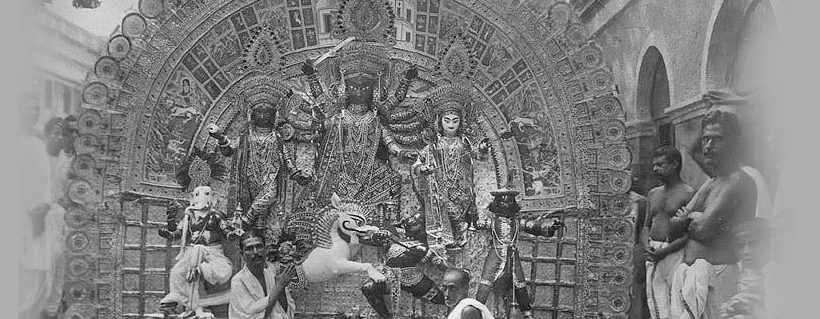
Durga Puja is one of the most important and popular festivities of West Bengal. Most of us are aware of this festivity, but none of us has got a clear idea about the story of Durga Puja. Well, in this article, we will provide you with some interesting legends of Durga Puja Festival that will enable you to understand the origin & history of Durga puja.
Legend of Creation of Goddess Durga
Goddess Durga represents the unification of all the divine forces to overpower the evil spirits. To fight with the demon Mahishasur, the gods decided to create a real powerful force. At that moment, it happened that a lightening came forth from the mouths of the three Hindu Gods, namely Brahma, Vishnu and Mahesh, giving rise to a gorgeous woman having ten hands. The deities supplied her with their weapons, thus giving her all the powers of universe.
Legend of Lord Rama
According to the epic Ramayana, Lord Ram performed the chandi puja, so as to seek the divine blessings of Goddess Durga. He did so for killing Ravana, the devil king of Lanka who had kidnapped his wife Sita. Goddess Durga secretly told him that he can kill Ravana. In the war between Rama and Ravana, Lord Rama succeeded in defeating the devil and returned to his kingdom along with his wife Sita and younger brother Lakshman.
Legend of Pandavas
According to the great Indian epic Mahabharta, the Pandavas wandered in the forests for a long period of 12 years. They kept their weapons on a Shami tree before leaving for the court of king Virat, where they spent their last one year in disguise. On the completion of that one year, which happened on the day of Vijayadashmi, i.e. Dussehra, they brought down the weapons that they had kept on the Shami tree. On this day, they came forward and revealed their true identity. Since then, this day is celebrated as Vijaydashmi or Dusshera and involves the exchange of Shami leaves as a symbol of victory and goodness.
Origin of Durga - The Mythology
In the ancient times, a demon called 'Mahishasura' earned the favour of 'Lord Shiva' after a long meditation. Shiva, pleased with the devotion of the demon, blessed him with a boon that no man or Deity would be able to kill him. Empowered with the boon, Mahishasura started his reign of terror over the World. People were killed mercilessly and even the Gods were driven out from heaven. The Gods went to Shiva for relief and informed him about the atrocities caused by the demon. Shiva, who is normally unaware of the happenings in the material world, became very angry after hearing all this. This anger came out in the form of an energy from Shiva's third eye and concentrated to form a woman. All the Gods who were present there contributed their share of energy to this Goddess and thus Durga, the eternal mother, was born. Riding a lion, she attacked Mahishasura. After a fierce battle, Durga transformed into Devi Chandika, the most ferocious form of the Goddess, and beheaded Mahishasura.
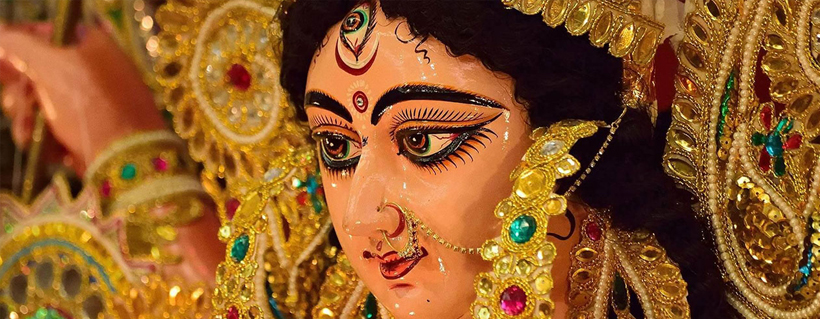
The Bengali Belief
Daksha, the king of the himalayas and the plains, and his wife, Menoka, had a daughter called Uma. Uma, right from her childhood, started worshipping Shiva as her would be husband. Shiva, being pleased with the worship of Uma, came to marry her. Daksha did not like this tiger-skin clad groom with ash & dirt spread over all of his body. Uma got married to Shiva but was prevented by her father from moving to Kailash, the abode of Shiva. Daksha, later on, arranged for a 'yagna' where everyone except Shiva was invited. Uma, feeling ashamed of the behaviour of her father and shocked by the attitude metted towards her husband, went on fast and finally died. Shiva came to know about this and went to Daksha's house. He lifted the body of Uma on his shoulders and started dancing madly. With the supreme power dancing, the World was on the verge of destruction. Narayana, another SuperGod, came forward as a saviour and used his 'Chakra' to cut the Body of Uma into pieces. Those pieces started falling off from the shoulder of the dancing Shiva into different parts of the World. Shiva was finally pacified when the last piece fell off from his shoulder. Narayana revived Uma for a new life. Daksha, who was extremely sorry about his misdeeds, prayed for mercy and was finally forgiven. The places where the pieces had fallen are known as the 'Shakti Piths' or energy pits, few of these places being Kalighat in Calcutta, Kamakshya near Guwahati among others. Ever since peace was restored, Uma, with her four children, Ganesh, Kartick, Saraswati and Laxmi and with her two 'sakhis' - Jaya and Bijaya, comes to visit her parent's home each year during the season of 'Sharat' or autumn when Durga Puja is celebrated.
What the Epics Say - 'Akalbodhan'
In the 'Ramayana', as it goes, Rama went to 'Lanka' to rescue his abducted wife, Sita, from the grip of Ravana, the king of the Demons in Lanka. Before starting for his battle with Ravana, Rama wanted the blessings of Devi Durga . He came to know that the Goddess would be pleased only if she is worshipped with one hundred 'NeelKamal' or blue lotuses. Rama, after travelling the whole world, could gather only ninety nine of them. He finally decided to offer one of his eyes, which resembled blue lotuses. Durga, being pleased with the devotion of Rama, appeared before him and blessed him. The battle started on the 'Saptami' and Ravana was finally killed on the 'Sandhikshan' i.e. the crossover period between Ashtami (the next day) and Navami (the day after). Ravana was cremated on Dashami. Since the period of this worship was different from the conventional period (during the spring - 'Basanta'), this puja is also known as 'Akal-Bodhan' or a worship (Bodhan) in an unconventional time (A-Kaal).
The origin of festival of Durga puja comes with its own retinue of mythological stories. The most prevalent among them is the one involving Lord Rama, the hero of the Hindu epic, Ramayana. When Ravana (the 10-headed demon king of Lanka, now Ceylon) abducted Lord Rama’s wife Sita, and held her hostage in Lanka, a fierce battle ensued. Although there were huge casualties on both sides, Ravana could not be defeated. So Rama decided to seek the blessings of Shakti or Goddess Durga in order to defeat the 10-headed demon.
But here comes the twist in the tale. 108 blue lotuses were needed for the worship of the Divine Mother and Rama had managed to procure only 107. He was on the verge of laying one of his eyes that was lotus-shaped and blue in colour at the Goddess’s feet when Shakti, satisfied with the measure of his devotion, granted her blessings. And the righteous eventually triumphed
.
The right time for the worship of Goddess Durga being in spring, the prayers of Lord Rama are also known as akal bodhan (untimely worship). Nowadays, Ram Navmi is celebrated during spring and Durga Puja or Dussehra is celebrated during autumn.
Prevalent in Bengal is the tale of the defeat of the demon, Mahishasura at the hands of Goddess Durga, the incarnation of Shakti, or Power. This demon was almost invincible because of a boon granted by Lord Shiva (the Destroyer in the Hindu Holy Trinity of Creator-Preserver-Destroyer) whereby no male could defeat him. But the gods found a novel solution to the daunting problem. The amalgamation of the might of all the gods resulted in the birth of Shakti in the form of Goddess Durga, who wielded an assortment of weapons in her 10 hands and rode a lion. Predictably enough, she was able to slay the demon, thus ending his reign of terror. Therefore, Durga is also called Mahishasuramardini (the slayer of Mahishasura). This holy battle has come to symbolise the triumph of Good over Evil.
However, according to another legend about Durga, she was a manifestation of Parvati, Shiva’s consort. It seems that while Parvati existed only for Shiva, Durga was the form of Parvati’s shakti (power) that was created solely for destroying demoniac forces.
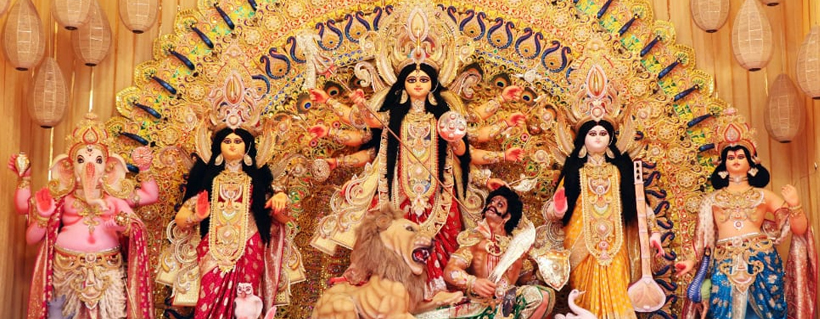
The Termination of Mahishasura
Confident but confused by the humiliating defeat of his loyal and powerful commanders Mahishasura did his best in arranging and equipping his personal army.
This time the heaven was led by Durga as the boon of Mahishasura could only make him invincible against all but woman. Surrounded by chants of praise, the blowing of horns the beating of drums and songs of worship Durga roamed the battlefield on her mighty lion. From her divine breath her army was constantly replenished with new warriors, each able, brave and resolute.
Shocked and enraged by the disastrous events on the battlefield. In a mad desperate bid Mahishasura then reverted to his own form, a buffalo, and charged about on the battlefield. In a wild rage he charged at Durga's divine soldiers wounding many, biting others and all the while thrashing with his long, whip-like tail. Durga's lion, angered by the presence of the demon-buffalo, attacked him. While he was thus engaged, Durga threw her noose around his neck.
But through magical spell Mahishasura kept changing his shape and form from one to another so as to puzzle the Devi.
Finally the Goddess beheaded the buffalo and from it emerged Mahishasura in his original form. Durga pierced his chest with the trident and relieved the world from the evil power.
The gods returned to heaven, and along with the sages of the earth, they sang praises and showered floral compliments to the Goddess Durga. Henceforth, and to this day, the Goddess Durga is worshipped by all the gods in heaven, and all human beings on earth. Mahishasura is there too--frozen in his moment of final defeat, impaled by Durga's spear and seeking pardon beneath her left foot. The Goddess Durga then continued to be worshipped in this form.
According to Puranas (the epics) , King Suratha, used to worship the goddess Durga in spring. Thus Durga Puja was also known as Basanti Puja (Basanta being Spring). While the vernal worship of Durga still goes on but it is the Ram's Akalbodhan during the autumn that came to be a most widely accepted practice.
In the 'Ramayana', as it goes, Rama went to 'Lanka' to rescue his abducted wife, Sita, from the grip of Ravana, the king of the Demons in Lanka. Before starting for his battle with Ravana, Rama wanted the blessings of Devi Durga . He came to know that the Goddess would be pleased only if she is worshipped with one hundred 'NeelKamal' or blue lotuses. Rama, after travelling the whole world, could gather only ninety nine of them. He finally decided to offer one of his eyes, which resembled blue lotuses. Durga, being pleased with the devotion of Rama, appeared before him and blessed him. The epical battle started on the 'Saptami' and Ravana was finally killed on the 'Sandhikshan' i.e. the crossover period between Ashtami (the next day) and Navami (the day after). Ravana was cremated on Dashami. This is why Dashera is celebrated in India with so much of fanfare and the effigy of Raavana is burnt.
In course of time Bengalis adopted the autumnal worship of Durga performed by Rama and made it their main festival. The Pujas span over the four days, the time taken by Rama to finally kill and cremate Ravana.
